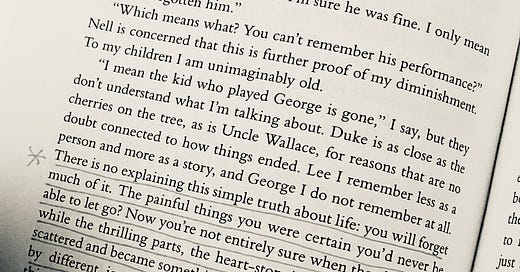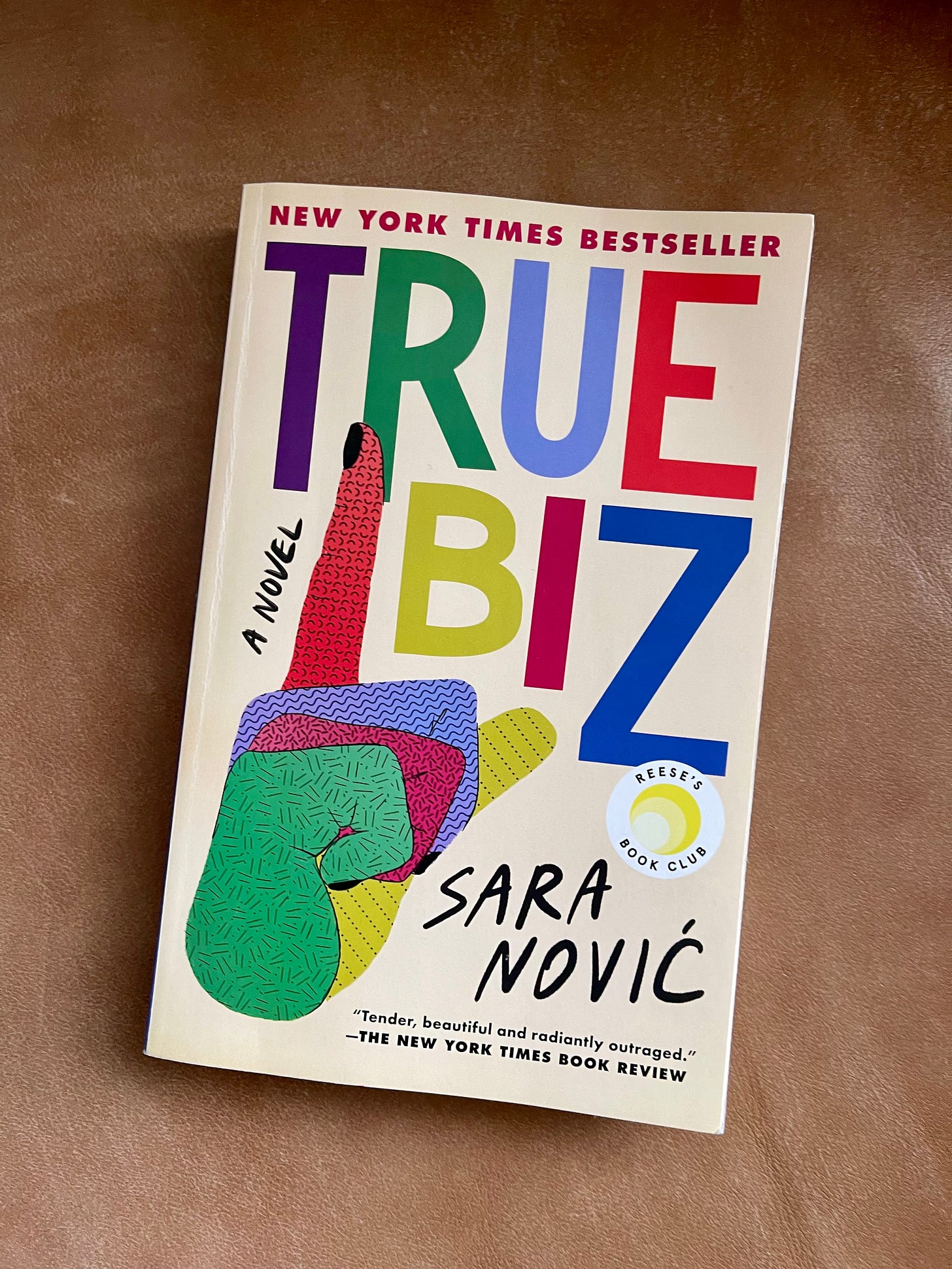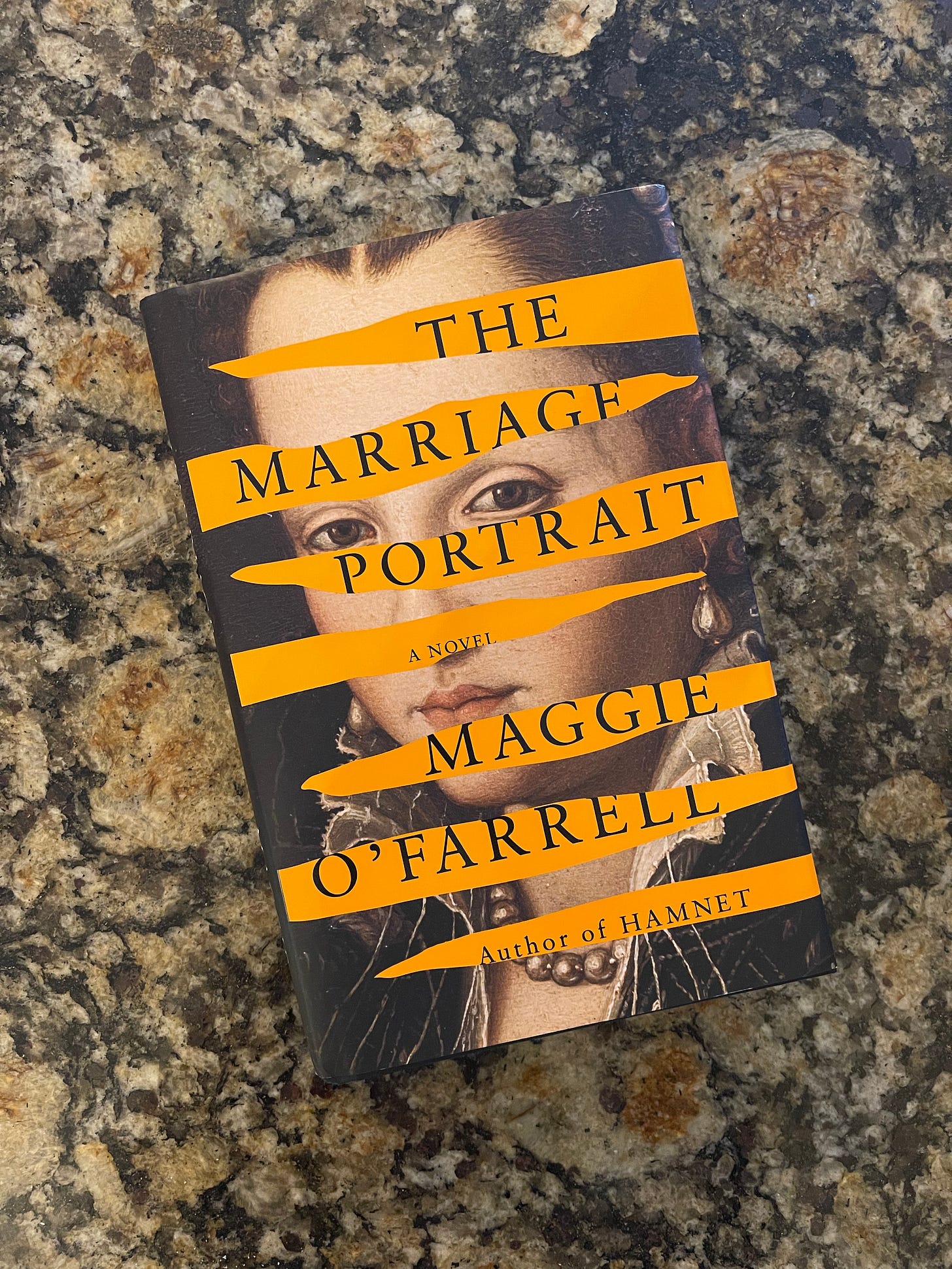It’s been an interesting start to the year reading-wise. I feel like I’ve been all over the map, and I suppose I truly was! My husband and I took a trip to St. John in early January and it was such a joy to be on an adventure with him again! That said, my reading shifted a bit at the beginning of the year and I spent some delightful time with Elin Hilderbrand’s Paradise Trilogy. It’s not my normal, but they were light and fun, and when in St. John, read about St. John!
My Book Club’s February Pick: Ann Patchett’s Tom Lake
It’s been a year since this group of women got together for the first time in my living room, for this (most) monthly gathering to talk books and life. Some of us have read and outlined complex theme charts (it’s me, hi, I’m the problem, it’s me 🙋♀️) and others just come for the wine (you know who you are and I love you 😘). This was a beautiful discussion that ran the gamut from motherhood to memories and more in between. Below is my review of this lovely novel, which only made me fall deeper for Ann Patchett.

“It all happened a long time ago. The rage dissipates along with the love, and all we’re left with is a story.” -Lara Nelson
The year is 2020, and it is harvest time at the Nelson family's Michigan cherry farm. Lara and Joe welcome their three grown daughters, Emily, Maisie, and Nell, back to the farm when colleges and universities close up due to the pandemic. They have so much work to do, and a very few seasonal workers to help this year, so the girls pitch in and put in long days in the orchards. Rather than fretting over the news or their phones, they ask Lara to tell the story of the summer she fell in love with a rising movie star (and was almost one herself).
Lara feel herself borne back ceaselessly into that past: the season at Tom Lake, a summer stock theater where Lara played Emily in Our Town. It was there she met Peter Duke, a fellow cast member, and their chemistry was instant and undeniable. Love. Success. Betrayal. The search for something that will last.
The story is told with dual timelines, back and forth between the summer stock theatre and the cherry orchards. Patchett beautifully reminds us of the lives lived before becoming parents, before marriage. The different people we have been and the way those sinews are all a part of the same body we inhabit today. I found such a resonance with the contrast of youthful love and the love of a lifelong partnership, that singular strength found in loving something so completely together that it doesn’t make the work less hard. But it does give you someone to work alongside you. What Lara & Joe have made is the sticking kind of love, and it is beautiful to behold.
And the character development is so rock solid, each daughter has her own clear and unique personality and yet they have that common language that only sisters do.
Emily plans to marry the boy from the next orchard over and continue to work the farm with a levelheadedness that borders on stoicism.
Maisie is finishing veterinary school and is always taking in strays (animals and otherwise).
And Nell, an aspiring actress herself with a wise understanding of the world that neither of her sisters possess.
As Lara continues to tell the story, wounds surface that, together under this canopy of cherry blossoms, will either heal or fracture further. As the tensions of the pandemic and of who Duke becomes build simultaneously, Patchett asks the question of how we find joy when the world is falling to shambles.
Lara has such a kindness for her younger, naive self, a compassion I think many of us could learn from. There is a humanness at work in this novel that Patchett elevates with an elegiac accuracy: looking back over a life and realizing that the moment right now is where you most want to be. I’ll close with one more quote that shows just how well that theme is pulled through the novel.
“There is no explaining this simple truth about life: you will forget much of it. The painful things you were certain you’d never be able to let go? Now you're not entirely sure when they happened, while the thrilling parts, the heart-stopping joys, splintered and scattered and became something else. Memories are then replaced by different joys and larger sorrows, and unbelievably, those things get knocked aside as well, until one morning you're picking cherries with your three grown daughters and your husband goes by on the Gator and you are positive that this is all you've ever wanted in the world.”
Another February Favorite: True Biz
“But language bears more than the work of communicating with the mainstream world; it is also the internal vehicle for our thoughts and feelings, the mechanism through which we understand ourselves. Without first having had ASL, I would not have understood myself as a person with a story to tell.”
-Sara Nović
This novel was an exercise in the power of fiction to activate empathy, and it was such an important learning experience for me. Not only were the main characters incredibly compelling, but there is so much about Deaf culture and injustices perpetuated on the Deaf community that I knew nothing about. Injustices as old as ancient Egypt and the Milan Conference of 1880, and those that continue to inflict harm today.* Thank you, Sara Nović, for bringing this history (both past and current) to light through the means of an entirely engrossing novel. The entire novel acts as a call to action, to stand up with this beautiful community. As Nović writes in the author’s note, “What happens to a place and characters like those in the novel? It’s up to you.”
The story is set at a residential school for the deaf, as the hearing Headmistress February Waters fights to keep the River Valley School for the Deaf open as the public funding is pulled out from under the institution. She is a CODA, and her deaf mother lives at home with her, but her dementia is increasingly more potent. February finds herself under enormous pressure with the weight of the impending school closure, her mother’s care needs, and discord with her wife.
Austin is a high schooler at River Valley, the youngest of the Workman family who are famed in the Deaf community of Ohio for having five generations of Deaf family members that Austin is the latest and proudest of. But when Austin’s mother gives birth to a hearing child, everything he knows about the gift of being Deaf is called into question. And when he gets to know the new girl, the foundations of his view of himself begin to shake.
Charlie is a new student, entering River Valley as a high schooler, an extreme rarity. She had a cochlear implant as a small child but it has clearly failed, and her divorced parents no longer know how to support her. She comes to River Valley never having met another Deaf person and knowing no ASL at all. Rather than blending into the wallpaper of the school, her years of language deprivation put her on the radar of other students immediately. Her immersion is frustrating, alienating, and essential. Will a supportive Deaf community be enough to untangle all the lies Charlie has believed about herself and show Charlie her worth?

This book was heartrending and beautiful, the community in and around River Valley School were artfully written, and the main characters were compelling. I also loved how immersive it was, asking those of us not fluent in ASL to do a little work.
*Injustices against the deaf community persist today. For instance, as early as 2003, one of the leading manufacturers of cochlear implants (Advanced Bionics) knew that their technologies were permeable to leaks. The devices were recalled in 2004 and then sent back out to market two months later. By the time they recalled devices again, some 4,000 children had surgeries to receive implants. These implants took on moisture, which caused electric shocks, and seizures, and some defective devices caused irreparable damage to patients’ ears. It wasn’t until a court case in 2015 that some of these families received settlements from the company: a sliver of justice for the losses.
This month’s unputdownable novel: The Marriage Portrait
O’Farrell is fast becoming one of my favorites. I loved Hamnet and The Vanishing Act of Esme Lennox, but this was a triumph all its own. I was immediately engulfed in the characters, the period, the story. So much so, that I read it in three days (on weeknights no less 🫢). Based on the history of the famed Medici family and their daughter, Lucrezia, who inspired Robert Browning’s poem, “My Last Duchess.”
Lucrezia is the third daughter of Cosimo de Medici, growing up in a lavish Florentine palazzo where she doesn’t quite fit in anywhere. She found solace in her art, excelling in drawing and painting from a very young age, and was brought into arts tutelage under one of the masters. She especially loves painting on tavola, pieces of wood that can be used over and over to paint layered pictures upon each other (known as underpainting and overpainting).
Her elder sister, Maria, is engaged to Alfonso II, the soon-to-be Duke of Ferrera. When Maria dies suddenly, Alfonso is quick to extend the marriage proposal to the next Medici daughter in line: Lucrezia, who is only 13 years old. Her family delays the match for two years, but the marriage is advantageous for both families, so it goes ahead.
Lucrezia must journey through the Apennine Mountains with her new husband to a land she does not know and a court she does not understand with only her maid, Emilia, for company. Once she arrives, she finds herself unprepared for the drama and treachery of life in the Court of Ferrara. And she realizes she has one job and one alone: to bear a male heir to the Ferrara duchy.
But the real change is within her husband himself. Lucrezia finds herself caught between the two sides of her husband, like the myth of Janus. At times he is lavish and kind, but it takes only a small act to provoke him to rage. Amidst this confusion, Alfonso commissions a portrait of his wife, as the famed portrait by Bronzino is not to his liking. He wants the world to know what a catch he has. As Lucrezia continues to remain without child, Alfonso is increasingly displeased with the match and begins to plot something quite sinister, alongside his friend and consigliere, Leonello. Alfonso becomes what Lucrezia has studied for so long, a painting with a beautiful facade hiding shadowy truths of another thing altogether at work underneath.

This was a fascinating read! The way that O’Farrell took a famous work of art and crafted a whole world that felt true to the Renaissance era was simply magnificent. Her immersive storytelling style took me deep into the Medici court and I didn’t come up for air until the last page. Fans of Girl with a Pearl Earring will love this!
What’s on RSM’s March TBR Pile?
Night of the Living Rez - Morgan Talty
Erosion - Terry Tempest Williams
Field Notes for the Wilderness - Sarah Bessey
Nathan Coulter - Wendell Berry
Family Lore - Elizabeth Acevedo
Four Treasures of the Sky - Jenny Tinghui Zhang
Thanks for joining me here, dear readers. Happy page-turning!
From my shelves to yours,
-RSM









